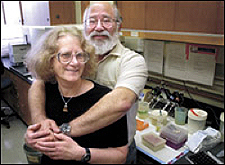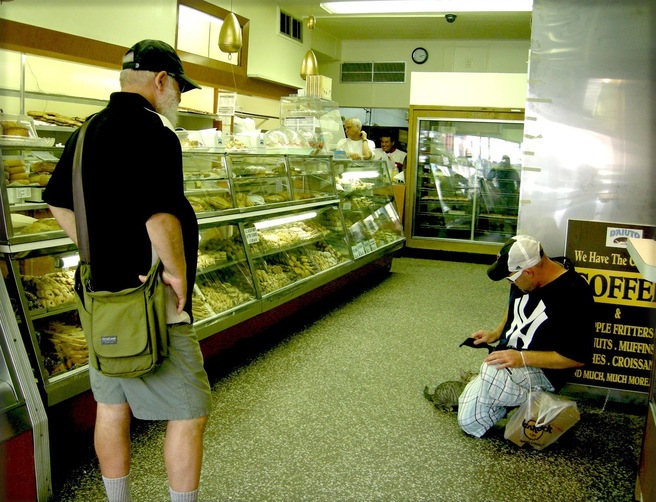I had forgotten about this, but in 2004 a reporter for the Corvallis newspaper, the Gazette-Times, did a story on us for Valentines Day:
Couple loves every minute
Pair of OSU science professors share close to every waking moment together
By THERESA HOGUE Gazette-Times February 14 2004
For some
couples, the secret to a long-lasting marriage is maintaining a certain
independence, a special piece of life that is separate from the other
partner's.
Some even
take separate vacations, and most at least have a job or hobby that takes them
away from their house, and their spouse, for at least part of the day.
But when
you ask Ev and Barry Sherr about taking time off from each other, they exchange
confused glances. The two Oregon State University professors of oceanic and
atmospheric science work side by side all day, and go home together at night,
and never complain that they're seeing too much of each other.
"We're
used to being together," Ev says, her eyes locking with Barry's.
"It's hard for us to be apart."
Barry is a
little less sentimental. He can think of plenty of times that they're not
together.
"When
we come home, I sit on the couch and watch TV while she's in the kitchen,"
he volunteers as proof of their time apart.
Ev and
Barry haven't been apart too often since they met 30 years ago. At the time,
Barry was a Ph.D. student at the University of Georgia, studying estuaries on
Sapelo Island off the coast of Georgia. Ev was a post-doc researcher who came
to Sapelo as a senior scientist on the same project.
When they first met, they
were each married to other people. Ev's husband was also an academic, who lived
on the mainland while Ev lived on the island. Barry's wife was living far away
as well, and neither couple was spending much time together.
Work was the focus for Ev
and Barry for the first few years, as Barry worked on completing his degree,
and Ev was busy with her research. But once Barry finished his course work, he
returned to the island, and love began to grow.
Both marriages had
subsequently fallen apart, and the island, isolated and beautiful, was a
natural backdrop for their relationship.
"It was a magic place,"
Ev said. "There was a deserted beach, and because it was isolated, it was
a pretty romantic place."
While their first
marriages had dissolved in part because of distance, their new relationship
grew because of their proximity, and a shared passion for oceanography.
When Barry got the
opportunity to do post doctorate work in Israel, they decided to marry, making
it easier for them to travel together and live abroad. Ev took a year and a
half leave from work on the island, and they flew to Israel just a week after
their wedding day, Sept. 11, 1979.
Barry, who admittedly is
a little light on romance, pointed out that the date of their anniversary is
now a hard one to forget.
After completing his work
in Israel, Barry returned with Ev to the island, where they continued to live
and work from 1981 until 1990. They adopted one child, Aaron, in 1982, and nine
months after his adoption, Ev discovered she was pregnant. Their second son,
Jared, is now a freshman in physics at the University of Oregon.
The children led a
sheltered life on the island, which had few inhabitants and no school. The boys
had to take a 45-minute boat ride to the mainland and another 45-minute bus
ride just to get to school.
"We wanted to get
off the island," Ev said. "But the problem is working together as a
research team, it's not that easy to find a job."
Oregon's higher education
system has a history of supporting duel-career couples, and when a position
opened up at OSU, the Sherrs jumped at the chance. The university allowed them
to split the position between them, allowing the couple more time to raise
their family.
Ev said their colleagues
don't understand how a married couple can survive being together 24 hours a
day, but Barry shrugs it off with a little chuckle.
"You can get used to
anything," he joked. "Time flies."
Research does
occasionally split the couple for a few months, including the time Barry spent
half a year on the Arctic Ocean. Ev has two 40-day cruises to go on this year,
which Barry said he's "not looking forward to."
"Mainly because I'll
have to take care of the dog and the house, and our eldest son moved in with
his cat, so now we have a grand-cat," Barry grumbled. He didn't mention
the part where he'd miss Ev, but he didn't have to.
When they're apart, the
couple e-mail each other daily, and have even discussed digital cameras
attached to their computers for video conferencing.
As for Valentine's Day,
the couple has no big plans. They don't exchange gifts or make a big deal out
of the day. In fact, the most romantic gift Ev can recall receiving is
something Barry and the kids gave her for Mother's Day a few years ago. Her
eyes lit up as she recalled the "wonderful" present.
"They gave me a
pressure cooker!" she said. "It was exactly what I wanted. I don't
want jewelry."
It must be true love.




